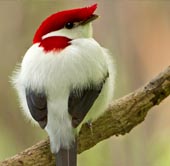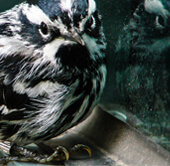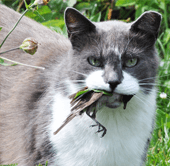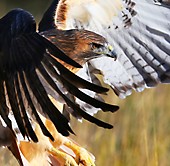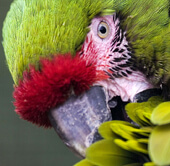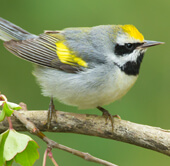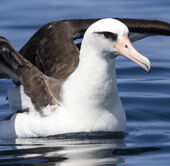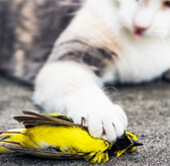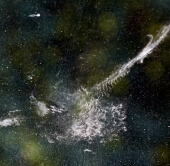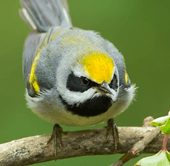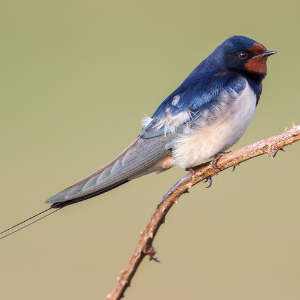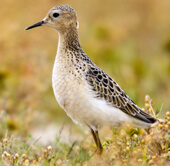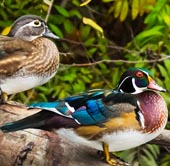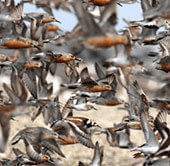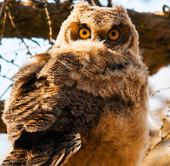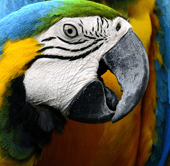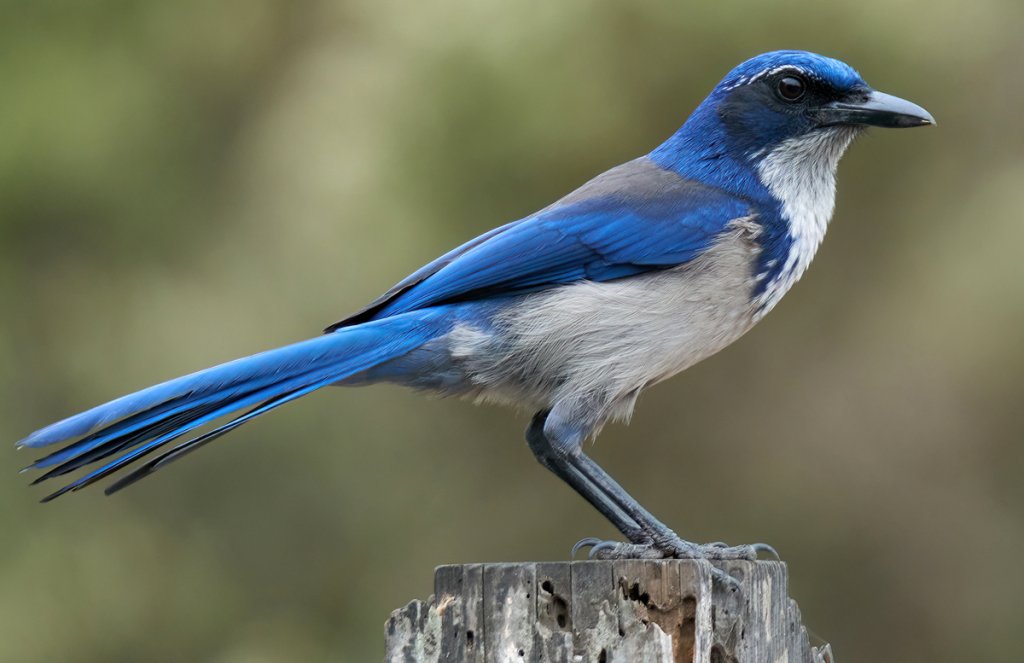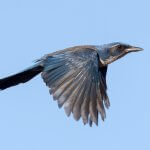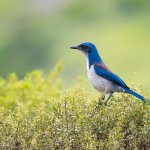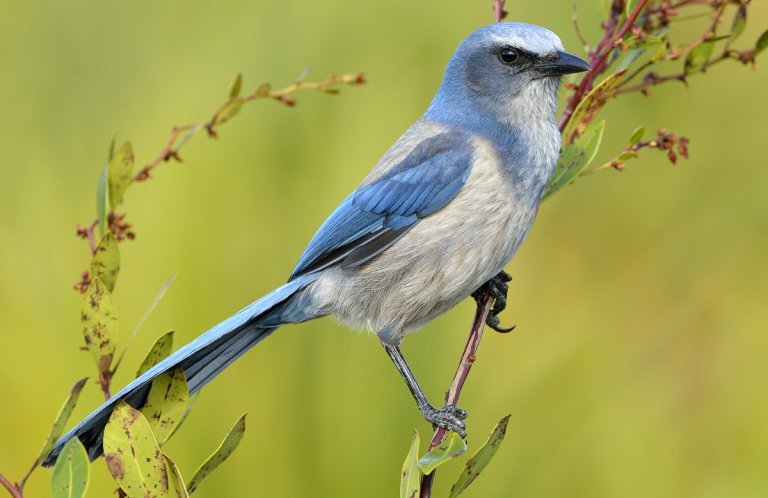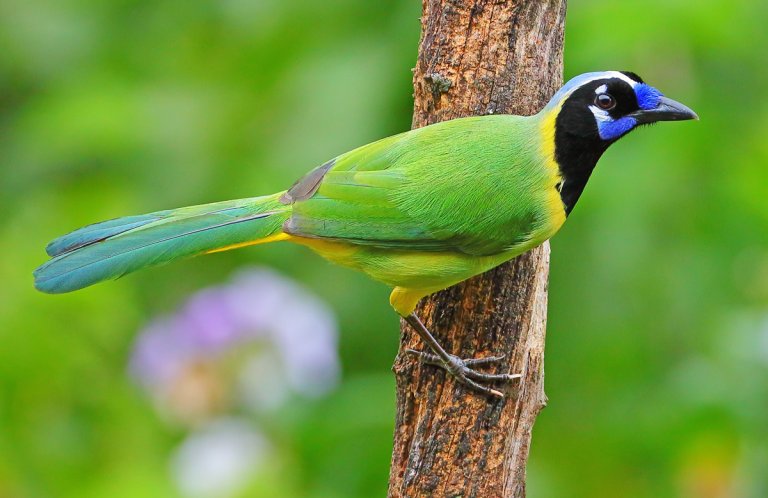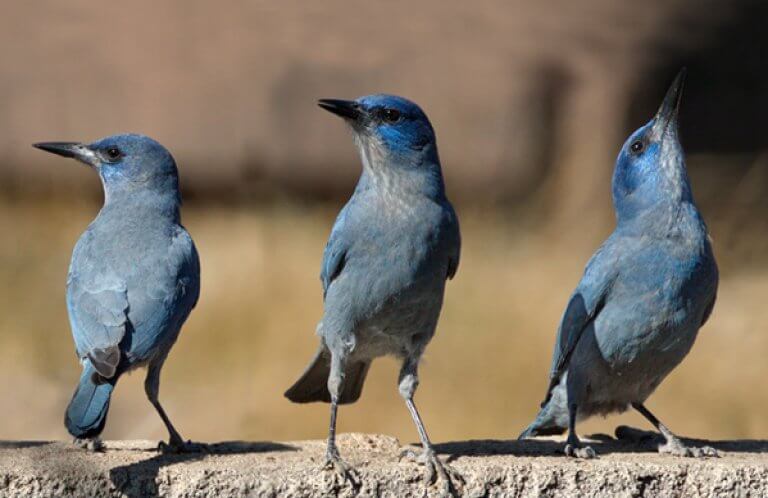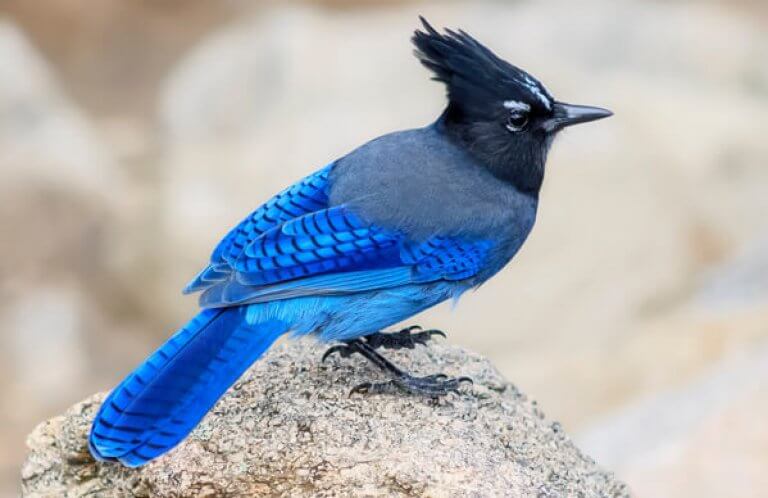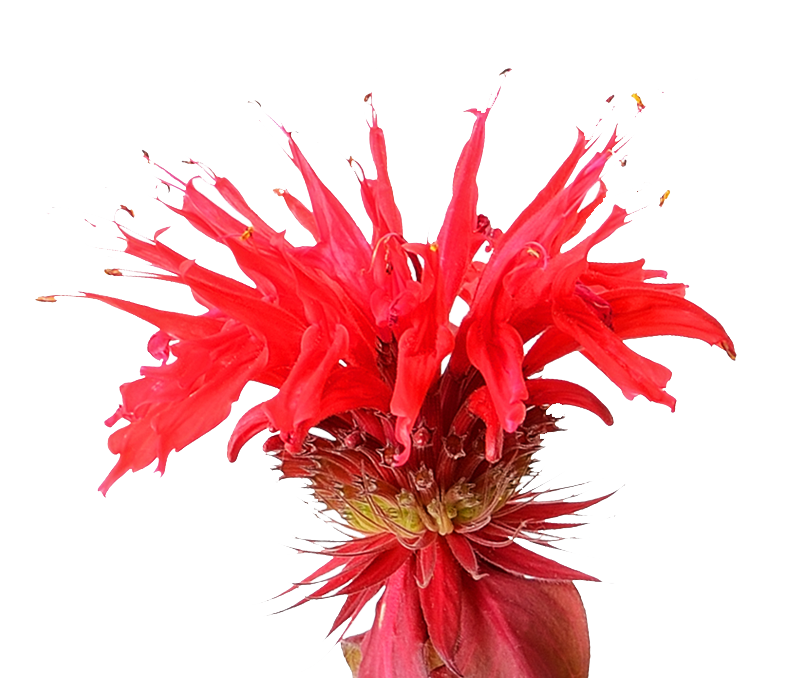About the Island Scrub-Jay
The Island Scrub-Jay is found nowhere in the world except on California's Santa Cruz Island, making it the only island endemic bird species north of Mexico. The bird was once considered part of the species known simply as the Scrub Jay, which was split into three species (Western, Island, and Florida Scrub-Jays) in 1995. The Island Scrub-Jay is noticeably larger and more brightly colored than its relatives, including the Florida Scrub-Jay (the only bird species endemic to Florida). Fossil remains suggest that Island Scrub-Jay probably diverged from its closest relative, the bird now known as California Scrub-Jay, about 150,000 years ago.
The Island Scrub-Jay has a bright blue crown, nape, upper wing, tail, and paler blue undertail coverts. It has a black face and white chin and throat, separated from the grayish-white underparts by an almost complete blue collar. Other ID features include a large gray-brown patch on the upper back and a large black bill. Juveniles are grayish-white overall, with blue wings and tail. Like other scrub-jays, it lacks a crest.
Like other species endemic to islands, such as Darwin's famous finches and birds of the Hawaiian archipelago, including the Palila, ‘I'iwi, and Kiwikiu, the Island Scrub-Jay evolved specialized adaptations in isolation, illustrating Darwin's theory of evolution. But the Island Scrub-Jay takes this theory a step further.
Oak and Pine Adaptations
The Island Scrub-Jay is an extensively studied species. It can be found in two distinct habitats on Santa Cruz Island: oak forests and scrub, and pine woods. Although these two habitats lie in close proximity to each other and the jays move freely between them, the birds that live in the oak forests have evolved shorter, stouter beaks which are ideal for hammering open acorns, while the scrub-jays of the pine forests have developed longer, shallower beaks that are perfect for accessing food buried within pine cone crevices.
These adaptations, which evolved on the same island in relatively contiguous habitats, contradict the idea that evolutionary changes only occur when populations are separated by a physical barrier, such as an ocean, mountain range, or inhospitable habitat. Apparently, species can diverge without isolation.
Songs and Sounds
Both sexes give loud, harsh calls, including raspy single notes and long “shek-shek-shek” series. It also produces low clucking and clicking sounds.
Flight call:
Call:
Breeding and Feeding
Monogamous, may stay with the same mate for life. Pairs defend a permanent territory year round. Birds maintain their pair bond through vocalizations; males perform courtship feeding.
A limited nesting area (Santa Cruz Island) means that around half of the adult population of Island Scrub-Jays are “floaters,” non-breeding birds without a defined territory. These birds sometimes form loose groups and range widely around the island, usually in areas unsuitable for nesting, such as grasslands.
Both members of an Island Scrub-Jay pair build their nest, a large, bulky cup of coarse sticks lined with finer twigs and rootlets. The nest can be placed anywhere from ground level to 40 feet off the ground.
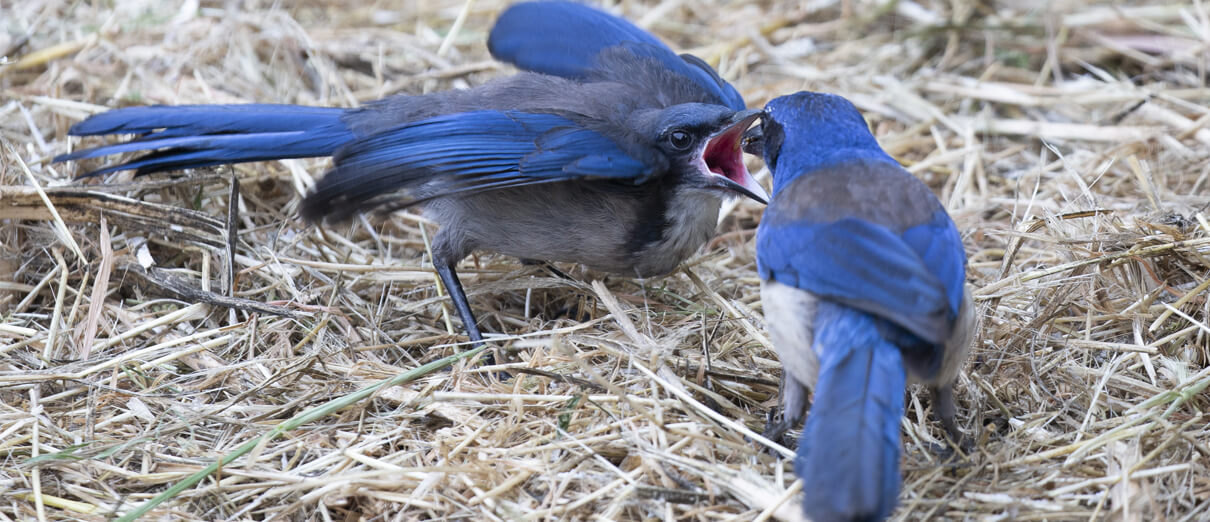
The female jay lays a clutch of three to five blue-green eggs, which she incubates for approximately two and a half weeks. Her mate brings her food while she sits on the nest. The naked, helpless hatchlings grow quickly, and clamber out of the nest before they can fly, where their parents continue to care for them. Young birds remain near their parent's territory for a short time, but soon join a flock of nonbreeders and disperse more widely.
The Island Scrub-Jay forages in a variety of ways: It gleans along the ground or tree branches, often opening its bill and sweeping its head from side to side to disturb the ground litter and expose prey. Some probe deeply into pine cones for seeds. This bird also flycatches in pursuit of aerial insects such as grasshoppers. Other prey include spiders, snakes, lizards, mice, and other birds' eggs and nestlings.
This jay's large bill easily handles thick-shelled acorns, a frequent food item. The Island Scrub-Jay caches large numbers of acorns each fall, burying the nuts in the ground or stashing them underneath logs, rocks, and tree bark. Besides providing a winter food source for the jay, this nut-caching habit is helping to restore Santa Cruz Island's oak woodlands.
Region and Range
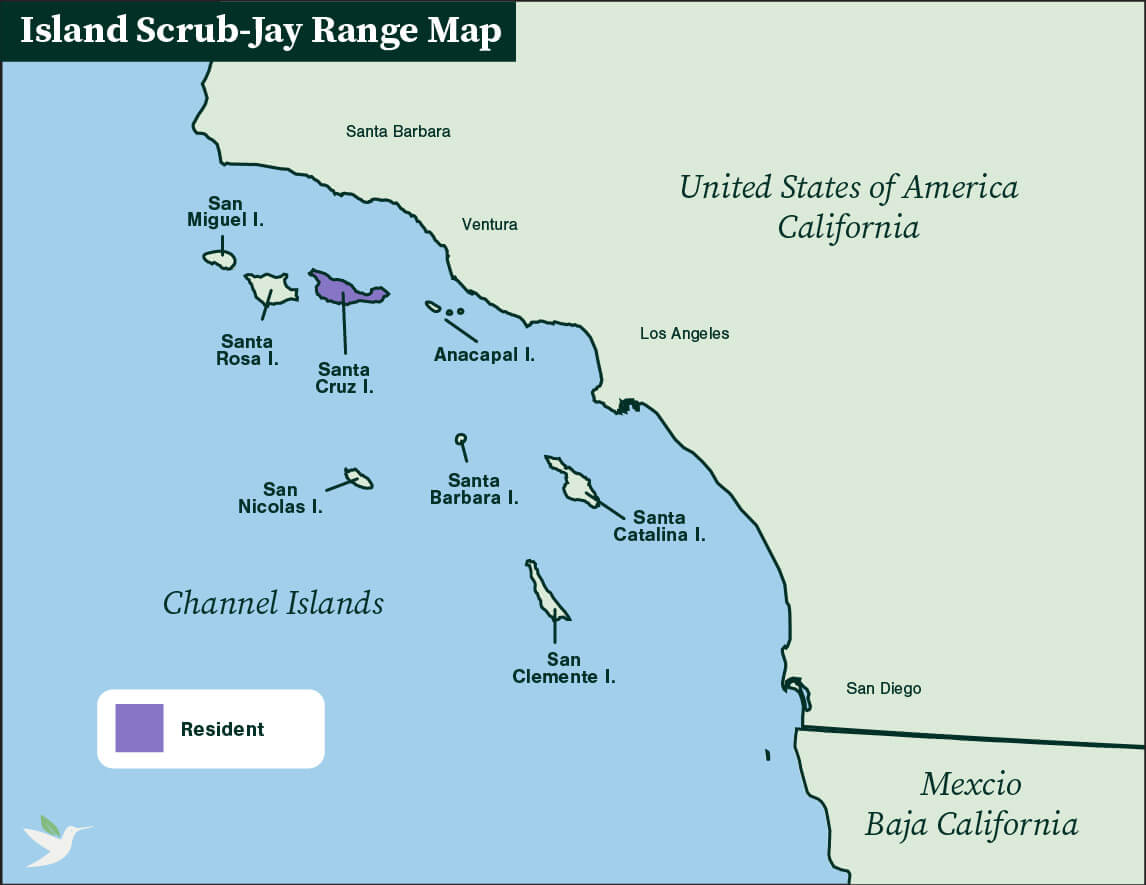
The Island Scrub-Jay is found only on Santa Cruz Island, the largest of California's Channel Islands. At roughly 24 miles long and 96 miles square, Santa Cruz Island is about the size of New York's Staten Island, and three times the size of Manhattan.
The Island Scrub-Jay inhabits oak and pine forests and scrublands throughout the island.
Conservation of the Island Scrub-Jay
Although non-native livestock such as sheep and feral pigs have been removed from Santa Cruz Island, threats remain from introduced, invasive plants and animals, including Argentine ants and the potential arrival of disease-carrying mosquitoes.
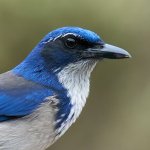
Help support ABC's conservation mission!
Changing climatic conditions can also cause an increase in the frequency of drought conditions and the subsequent threat of habitat-destroying fires. This is in addition to natural and human-caused fires, which can damage native ecosystems.
Introduced plants such as olive and Italian stone pine trees can crowd out native species.
In the future, an “insurance” population of Island Scrub Jay may be reintroduced to Santa Rosa Island, where this species once occurred.
A note about the Island Scrub-Jay's Red List status
For more than 130 years, taxonomists (experts in how bird species are related) have disagreed about the Island Scrub-Jay's status as a species and its connection to North America's other scrub-jays. And that in turn has affected its conservation status.
Since the bird was first described in 1886, North American authorities have considered it a full species and a subspecies at different times. Most recently, the American Ornithologists' Union (now the American Ornithological Society) recognized Island Scrub-Jay as a species in 1995, and it further split the Western Scrub-Jay in 2016 into California and Woodhouse's Scrub-Jays. Not long after the Island Scrub-Jay was declared a species, BirdLife International listed it as Vulnerable on the international Red List due to its small geographic range.
However, its Red List status changed in 2017 after BirdLife and Lynx Edicions published a checklist of the world's birds. The publication lumped Island Scrub-Jay with the widespread and common Western Scrub-Jay of the U.S. and Mexico, which is considered Least Concern on the Red List. That's where the bird's status remains in 2025.
Get Involved
Policies enacted by the U.S. Congress and federal agencies, such as the U.S. Fish and Wildlife Service, have a huge impact on U.S. birds. You can help shape these rules for the better by telling lawmakers to prioritize birds, bird habitat, and bird-friendly measures. To get started, visit ABC's Action Center.
Living a bird-friendly life can have an immediate impact on the birds around you. Doing so can be as easy as adding native plants to your garden, avoiding pesticides, and keeping cats indoors. To learn more, visit our Bird-Friendly Life page.
American Bird Conservancy and our Migratory Bird Joint Venture partners have improved conservation management on more than 8.5 million acres of U.S. bird habitat — an area larger than the state of Maryland — over the last ten years. This is a monumental undertaking, requiring the support of many, and you can help by making a gift today.

